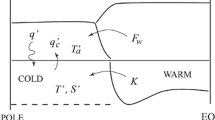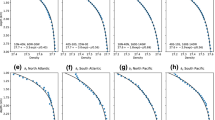Abstract
A simple nonlinear three-box ocean model of the North Atlantic Ocean including the rudiments of eddy mixing, vertical stratification and thermohaline circulation is first presented. It is subject to uniform latitudinal differential heating, q, and net evaporation m e , and includes a linear equation of state. Two quite different limiting steady-state solutions exist. The first has a warm saline surface water and a cold, low-salinity deep ocean; deep water is primarily formed in higher latitudes by the prevalence of differential heating. A second limiting solution consists of a warm saline deep ocean underlying a cool, low-salinity surface ocean; deep water is formed primarily in lower latitudes as a consequence of large differential evaporation. A coupled ocean-atmosphere model, in which the oceanic surface heat fluxes are determined internally but with differential evaporation at the ocean surface m e remaining an external parameter, is next presented. The atmosphere component is a simple energy balance model that emphasizes the vertical fluxes of radiative, sensible and latent heat fluxes but does not include temperature-albedo feedback. Model response depends on the external parameters m e and μ, controlling the magnitude of the thermohaline-driven circulation, and on the magnitudes of the eddy mixing coefficients and the solar constant. For small m e , a steady-state solution corresponding to a cold fresh deep ocean is found, qualitatively similar to the modern ocean. For large m e , a steady-state solution with a warm saline deep ocean occurs; this solution resembles conceptual models that have been proposed for the warm saline Cretaceous ocean. There exists an intermediate region of values of m e for which the solutions are more complex. On the lower end of this region, both the cold fresh deep-ocean and warm saline deep-ocean circulations coexist as stable equilibria. On the upper end, the cold-deep ocean becomes unstable, manifesting oscillations with growing amplitude, and ultimately reaches the warm saline deep-ocean solution. In the neighborhood of a ‘cusp’ on the μ, m e plane, that is, for relatively small μ, more complex behaviour occurs, which has not yet been fully analyzed. The model response in the region of complexity is not sensitive to changes in the solar constant but is sensitive to the eddy mixing coefficients.
Similar content being viewed by others
References
Birchfield GE, Weertman J, Lunde AT (1982) A model study of the role of high latitude topography in the climatic response to orbital insolation anomalies. J Atmos Sci 39:71–87
Boyle EA (1988) Vertical oceanic nutrient fractionation and glacial/interglacial CO2 cycles. Nature 331:55–56
Boyle EA, Keigwin L (1987) North Atlantic thermohaline circulation during the past 20 000 years linked to high-latitude surface temperature. Nature 330:35–40
Brass GW, Southam JR, Peterson WH (1982) Warm saline bottom water in the ancient ocean. Nature 296:620–623
Broecker WS (1987) Unpleasant surprises in the greenhouse? Nature 328:123–126
Broecker WS, Peteet DM, Rind D (1985) Does the ocean atmosphere system have more than one stable mode of operation? Nature 315:21–26
Bryan F (1986a) Maintenance and variability of the thermohaline circulation. PhD Dissertation, Princeton University, 254 pp
Bryan F (1986b) High-latitude salinity effects and interhemis-pheric thermohaline circulations. Nature 323:301–304
Ghil M, Childress S (1987) Topics in geophysical fluid dynamics: atmospheric dynamics, dynamo theory, and climate dynamics. Springer-Verlag, New York Berlin Heidelberg Toyko, 485 pp
Ghil M, Mullhaupt A, Pestiaux P (1987) Deep water formation and Quaternary glaciations. Climate Dyn 2:1–10
Gordon AL (1975) General ocean circulation. In: Numerical models of ocean circulation. Natl Acad Sci, Washington DC, 364 pp
Gordon AL (1986) Interocean exchange of thermocline water. J Geophys Res 91:5037–5046
Gordon AL, Taylor HW (1975) Heat and salt balance within the cold waters of the world ocean. In: Numerical models of ocean circulation. Natl Acad Sci, Washington DC, 364 pp
Hastenrath S (1982) On meridional heat transports in the world ocean. J Phys Oceanogr 12:922–927
Kennett JP (1977) Cenozoic evolution of Antarctic glaciation, the circum-Antarctic ocean, and their impact on global paleoceanography. J Geophys Res 82:3843–3860
Lamb HH (1972) Climate, present past and future, Volume 1, Methuen, 613 pp
Miller JR, Russell GL, Tsang LC (1983) Annual oceanic heat transports computed from an atmospheric model. Dyn Atmos Oceans 7:95–109
North GR, Mengel JG, Short DA (183) Simple energy balance model resolving the seasons and the continents: Application to the astronomical theory of the ice ages. J Geophys Res 88:6576–6586
Oort AH, Vonder Haar TH (1976) On the observed annual cycle in the ocean-atmosphere heat balance over the northern hemisphere. J Phys Oceanogr 6:781–800
Peterson WH (1979) A steady thermohaline convection model. PhD Dissertation, University of Miami
Rooth C (1982) Hydrology and ocean circulation. Progr Oceanogr 11:131–149
Stommel H (1961) Thermohaline convection with two stable regimes of flow. Tellus 13:224–228
Stommel H (1980) Asymmetry of interoceanic fresh-water and heat fluxes. Proc Natl Acad Sci USA 77:2377–2381
Suarez M, Held IM (1979) The sensitivity of an energy balance climate model to variations in the orbital parameters. J Geophys Res 84:4825–4836
Walin G (1985) The thermohaline circulation and the control of the ice ages. Palaeogeogr Palaeoclimatol Palaeoecol 50:323–332
Welander P (1981) Oscillations in a simple air-water system driven by a stabilizing heat flux. Dyn Atmos Oceans 5:269–280
Welander P (1982) A simple heat-salt oscillator. Dyn Atmos Oceans 6:233–242
Welander P (1986) Thermohaline effects in the ocean circulation and related simple models. In: J Willebrand, DLT Anderson (eds) Large-scale transport processes in oceans and atmosphere. D. Reidel, Dordrecht, 379 pp
Weyl P (1968) The role of the oceans in climatic change: A theory of the ice ages. Meteorol Monogr 8:37–62
Author information
Authors and Affiliations
Rights and permissions
About this article
Cite this article
Birchfield, G.E. A coupled ocean-atmosphere climate model: temperature versus salinity effects on the thermohaline circulation. Climate Dynamics 4, 57–71 (1989). https://doi.org/10.1007/BF00207400
Received:
Accepted:
Issue Date:
DOI: https://doi.org/10.1007/BF00207400




